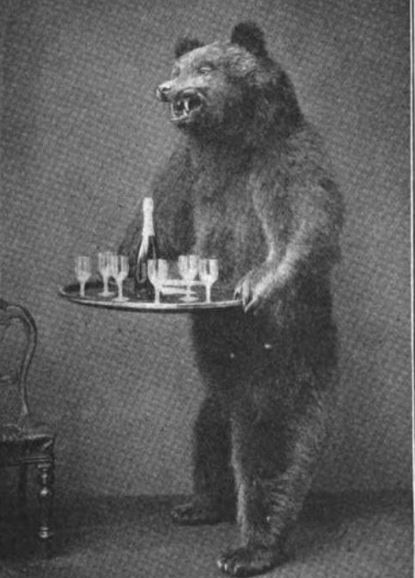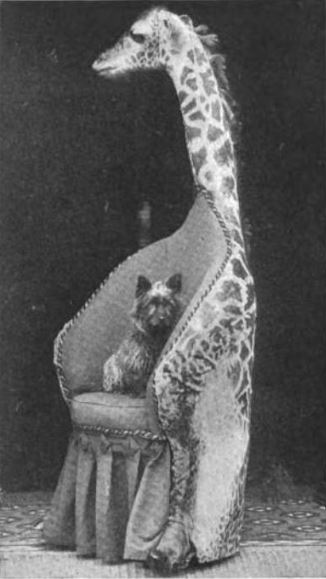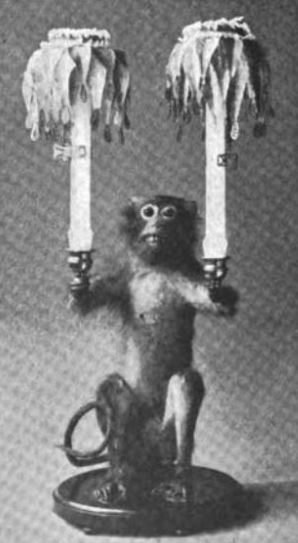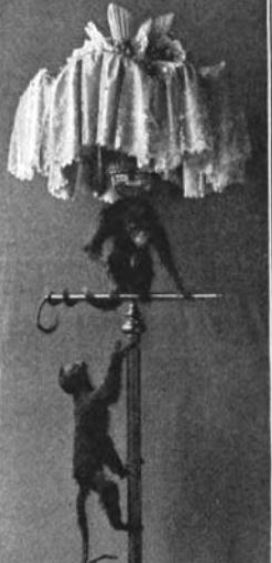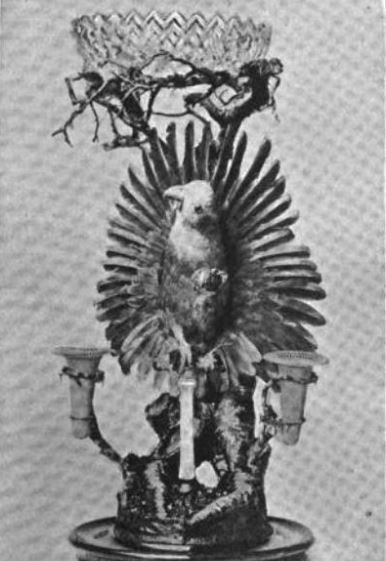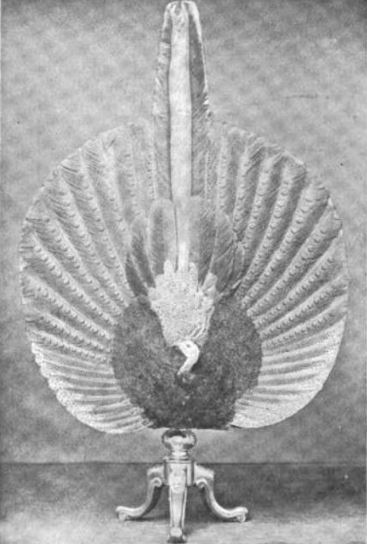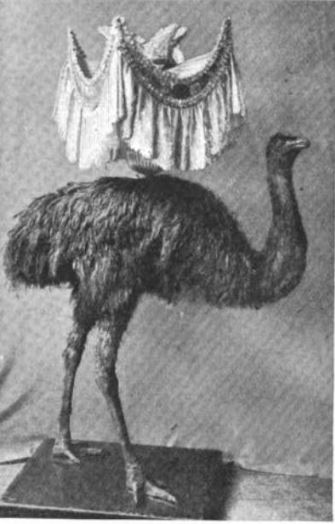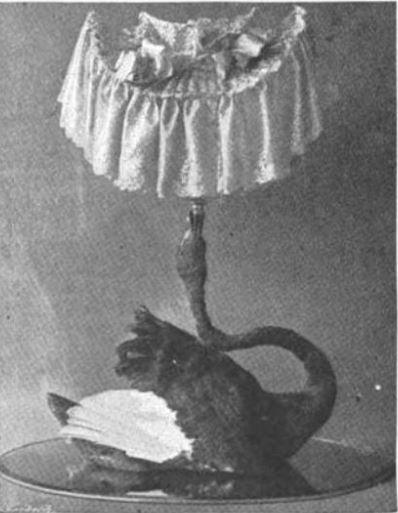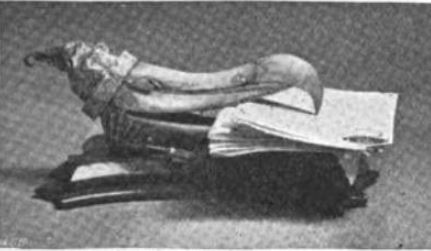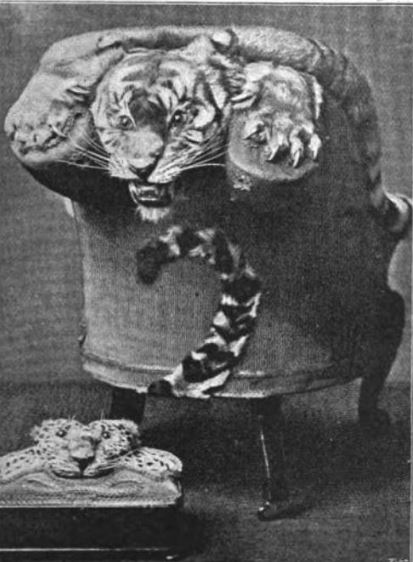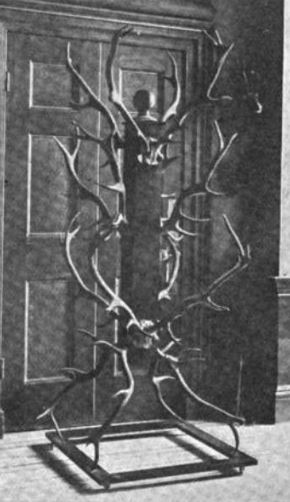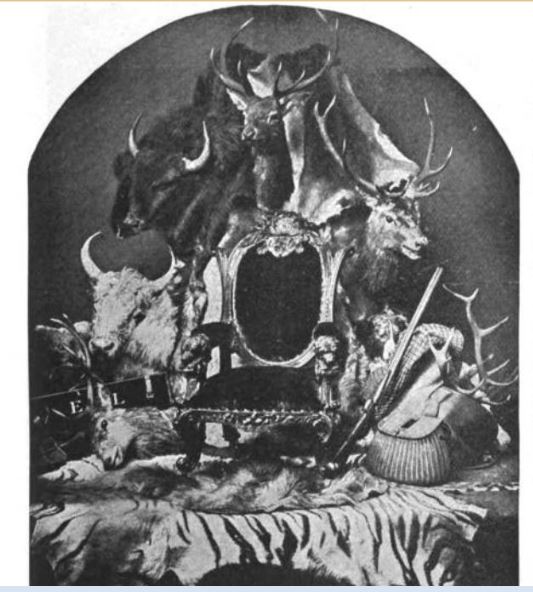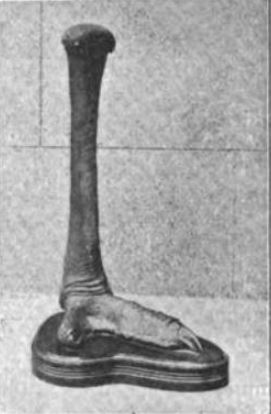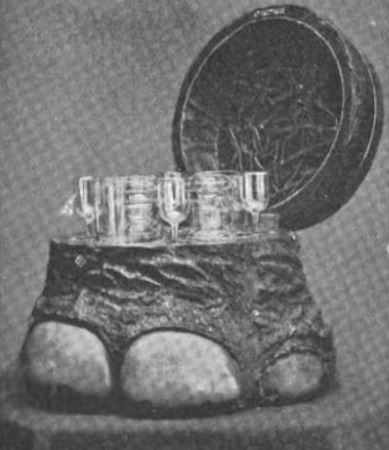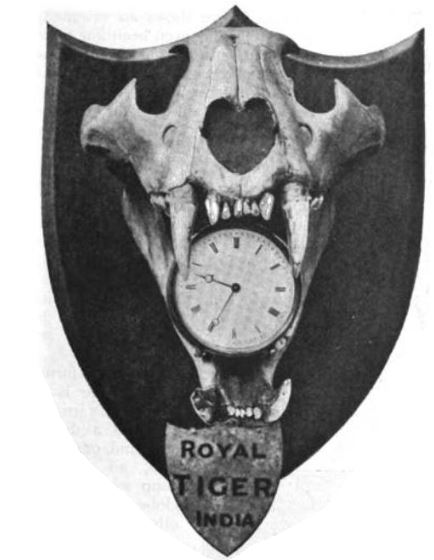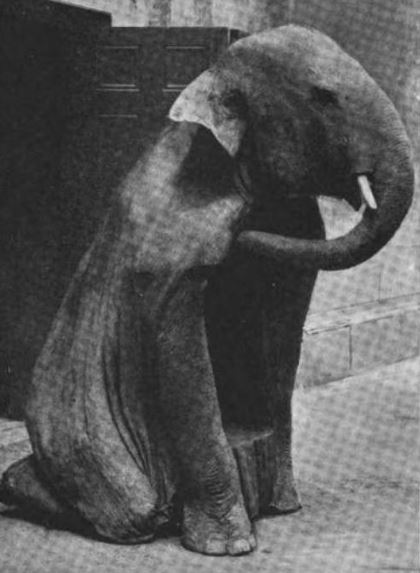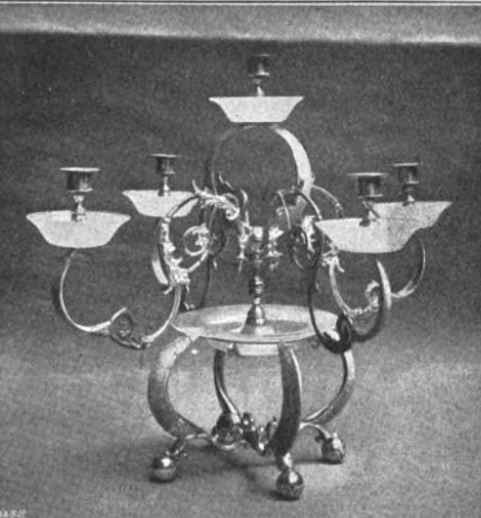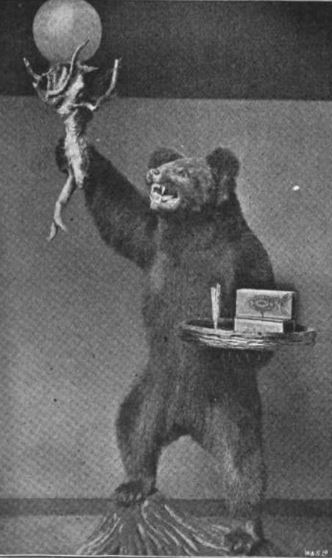Vexed With Orders for Dead Monkeys
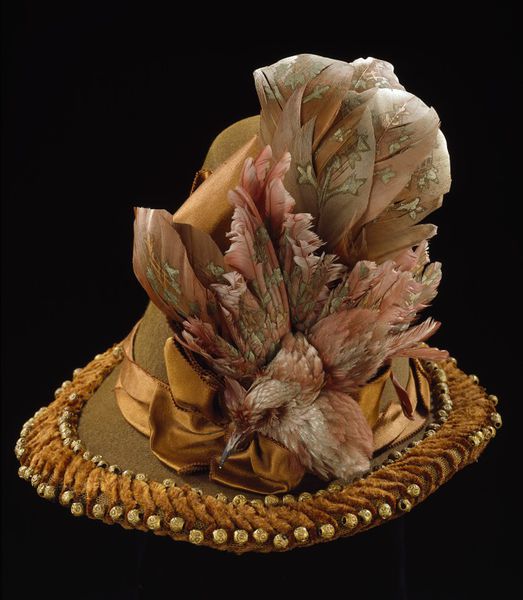
Vexed With Orders for Dead Monkeys An 1870s hat trimmed with a complete stuffed bird, although perhaps not an entire grouse. http://collections.vam.ac.uk/item/O1223604/hat-modes-du-louvre/
Taxidermy is making a comeback, in an ironic, hipster kind of way. You can take classes in how to stuff and mount white mice and rabbits, or perhaps squirrels or pigeons. Some proponents of the art like to pose the creatures and dress them up in little top hats or wedding veils. It is an odd hobby to find among a generation concerned about fair-trade coffee, ethically sourced clothing, and cruelty-free cosmetics.
If such things horrify you, I will issue for this post something that the hipsters are also fond of invoking: a trigger warning. For my theme today is not stuffed mice in steam-punk gear, but Victorian animal furniture. Prepare to be appalled.
We have all seen hunting trophies —for the most part mournful-looking heads—mounted in monotonous fashion and set up as ornaments in country houses; but he was really a “dreffle smart man” who first thought of adapting these trophies to every-day use— turning them, in fact, into articles of furniture.
Fancy lounging into the entrance-hall of a country mansion after a long ramble, and throwing your hat on the horn of a rhinoceros, which identical horn was once half buried in the writhing body of your host! And in saying this, I have a certain country seat in my mind. I also recall a titled lady who occasionally wears a necklace of gold-mounted bear’s claws, which correspond exactly with a number of frightful-looking scars on her noble husband’s back. Then, again, in the beautiful home of one of our greatest big game hunters there may be seen at this moment a superb tiger set up as a dumb —very dumbwaiter. That same tiger, however, wasn’t always so obliging, and he once nearly tore to pieces the very man he now stiffly supplies with a glass of grog and a cigar.
But look at this photo, and you will instantly realize what I am trying to convey.
The Prince of Wales’s Bear Mounted as a Dumb Waiter
This obsequious-looking bear was shot in Russia by no less a personage than the Prince of Wales; and for years it has “waited” meekly in the smoking-room at Marlborough House. The setting-up of this bear was intrusted to Mr. George F. Butt, F.Z.S., the eminent naturalist, of Wigmore Street, who has a perfect genius for transforming big game trophies into articles of furniture and general utility. From Mr. Butt I learn that this particular branch of taxidermy is about thirty years old, its origin dating from the time when ladies adopted the hideous fashion of wearing as hats whole grouse and pheasants. In the “Sixties,” when this craze was at its height, the naturalists couldn’t supply the birds fast enough—at four guineas each. “More grouse were worn than were eaten,” remarked Mr. Butt, gravely; “and not merely the wings, mark you, but the whole bird from head to tail.”
After these modish abominations came tiger and bear claw jewellery, the notion of which was imported from India; then followed various articles made from whole animals and parts of animals. One of the earliest designs was a horse’s hoof– that of a favourite charger—made into a silver-mounted inkstand. Chairs were also made which were supported by the four legs of a rhinoceros or zebra, or a favourite horse.
But without doubt the most original “animal” chair I ever beheld was that which belongs to that mighty Nimrod, Mr. J. Gardiner Muir, of “Hillcrest,” Market Harborough. This chair, as may be seen in the accompanying reproduction, is made from a baby giraffe, which, with its mother, was shot by Mr. Gardiner Muir, near the Kiboko River, in British East Africa. The design is by Rowland Ward, of Piccadilly. In the photograph will be noticed a little dog on the seat of the chair; this is the hunter’s little Scotch terrier, “Punch.”
Chair Made from a Baby Giraffe
It is quite astonishing to learn how many defunct animals are called upon to throw light upon things. I refer, of course, to animals converted into lamps. Some years ago a certain lady’s pet monkey died, and, although her grief was great, she resolved to have her dead darling turned into something useful as well as ornamental. In life that monkey had been phenomenally active – tweaking the noses of dignified people who least expected it; and the sorrowing mistress couldn’t bear to think of the poor little thing as a mere stuffed specimen grinning idiotically beneath a glass case. Therefore was that pet monkey – which is seen in the next illustration – set up as a candle – holder, grasping in its little fists the polished brass sconces, and with quite an eager, officious air.
Pet monkey candelabra
This set another fashion, and before long a Westend firm (Messrs. Williams and Bach, of New Bond Street) was doing a roaring trade in animal and bird lamps. The designs of many of these are remarkably ingenious. Here is another monkey lamp, in the design of which two active little fellows are supposed to be frolicking together, the topmost monkey bearing the oil-well after the manner of Atlas, with his tail coiled around the cross-bar, while his playfellow is scrambling up the pillar as though anxious to share the burden and the fun.
Monkey lamp
For some reason, innumerable monkeys were sold to light up billiard-rooms, the little animals swinging from a hoop with one hand and carrying the lamp in the other. After a time people other than those who had dead pet monkeys wanted to possess these unique lamps, so that defunct simians from the Zoo had to be eagerly bought up, and Mr. Jamrach, the famous wild beast importer, was vexed with orders for dead monkeys. Later on less uncommon pets—parrots and cockatoos—were utilized in a similar manner, and at length this latter form of the craze reached preposterous dimensions. Will it be believed that the Bond Street house (I have it on the authority of the manager) had actually to keep a stock of live parrots and cockatoos, so that aristocratic customers could select one for a swinging lamp? After selection, the doomed bird was sent along to the taxidermist, killed immediately, and then mounted in the style chosen. The parrots swung in brass hoops with outspread wings, and carried the lamps on their back; whilst cockatoos were “chained” to a perch. Oh! Fashion! what cruelties are perpetrated in thy name!
The Princess of Wales’s Favourite Parrot as a Fruit and Flower Stand
Of course the idea of turning into useful articles pets that have died from natural causes or old age is at once ingenious and praiseworthy. Here, for example, is a fruit and flower stand made by Mr. Geo. F. Butt for the Princess of Wales; it is now at Sandringham. The centre is a movable screen composed of a favourite parrot belonging to Her Royal Highness.
Giant Argus Pheasant, mounted as a fire-screen
Next is shown a beautiful fire-screen, also made by Mr. Butt for the Countess of Mayo. It is composed of a giant argus pheasant, which was shot by the late Earl at Singapore, only a short time before his own assassination.
An Emu Lamp
The emu and swan lamps, photos of which are reproduced on the next page, were made to the order of a wealthy Australian gentleman. The effect of the former in a drawing-room is curiously striking, but the latter is designed for a table lamp.
Black Swan Table Lamp (Mirror Represents Water)
The swan—a magnificent coal-black bird—rests upon a large mirror, so as to give the impression that the stately creature is floating on some placid lake.
Baroness Eckhardstein’s Gigantic Bear Holding Electric Light
The moment the door is opened at Baroness Eckhardstein’s beautiful house in Grosvenor Square, this gigantic and truly formidable bear is seen flooding the hall with a soft red light. This bear is one of the very largest ever seen in this country. It was shot during one of its fishing excurisons in Alaska, and set up to Rowland Ward, who presented it to the Baroness on the occasion of her marriage. The electric light can be switched on from behind. I must acknowledge here, with gratitude, the courtesy of the Baroness Eckhardstein, who permitted us to photograph this amiable monster.
Albatross Beak as Letter-clip
Very quaint and ingenious is the letter-clip next shown. It is made from the beak of an albatross, and is a relic with a history. A year or two ago a certain fool-hardy individual set out (as many have done) to cross the Atlantic in a craft, little larger than an open boat. The adventurous voyager did eventually make New York Harbour, but he was in a pitiable state of exhaustion. It transpired that before he had been many days at sea, he was attacked by an enormous albatross, which bird, one would think, was aware of the dangerous nature of the whole undertaking, and so commenced an unprovoked onslaught. The bird was shot, however, and its head ultimately brought to Mr. Butt to make up the beak as we see it here. Doubtless that mariner is still reminded of his lonely fight in mid-ocean every time he files a letter.
Man-Eating Tiger, Mounted on an Arm-chair
This “tiger chair” is a capital example of “animal” furniture. The seat is covered with the beautifully-marked skin, and the head and paws are so arranged as to give the impression that the terrible animal is about to spring. Observe the ingenious way in which the tail is disposed, as though the tiger were coiled right round the chair. This chair was made by Mr. Butt for a gentleman in the Indian Civil Service, and it is particularly interesting from the fact that the tiger was a dreaded man-eater, which had devastated and appalled several villages in Travancore. The day it was shot, this brute came into a village in search of a dainty meal, and succeeded in carrying off a little white girl, ten years of age. This child was afterwards rescued, but she was so shockingly lacerated that she died the same night in the house of a missionary doctor.
Sir Robert Harvey’s Horn Hat-Stand (Designed by Sir Edwin Landseer)
The next photograph reproduced here depicts a novel hat-stand, which adorns the entrance-hall at Langley Park, Slough, the beautiful seat of Sir Robert Harvey, Bart. It consists entirely of horns selected from stags shot in Invermark Forest, Forfarshire, by the present baronet and his father, during a ten years’ tenancy. The design is copied from one originally designed by Sir Edwin Landseer. Mention of this great artist bring us to another item of “animal” furniture—Landseer’s “otter” chair, which is seen in the next illustration.
Surrounding the chair are some heads — those of a favourite dog, a Scotch stag, a wild Chillingham bull, and an American bison—the three last shot by the painter himself. Landseer always admired otter skins, so a friend one day presented him with several very fine ones. These were subsequently spread on the chair by Mr. Butt, the head of the largest otter hanging down over the back in accordance with Landseer’s own design. In the house of a big game hunter you will come across all sorts of trophies, doing duty in various capacities.
Ostrich Leg as a Door-Stop
Here we see the leg of an ostrich mounted as a door-stop. Stranger still, we next behold the foot of a big elephant fashioned into a liqueur stand, so that it may be placed on the table in the midst of a group in reminiscent mood, Nimrods who may, perchance, be fighting their battles over again. This is one of Mr. Rowland Ward’s registered designs.
Elephant’s Foot as Liqueur Stand
The foot is that of an Indian elephant—a magnificent beast – shot by the then Duke of Edinburgh, during a well-known tour.
Very large elephant feet, by the way, are coveted trophies, and are, moreover, interesting indications of the height of their late possessor, twice the circumference of the forefoot giving the height of the elephant at the shoulder Strictly speaking, though, this rule applies more particularly to the Indian species.
Not the least interesting among the items of “animal” furniture that have come under my notice was a certain letter-box in a country house. The top part consisted of the skull of a once-notorious leopard, which had decimated great herds of cattle in its day, and required a vast deal of killing. Record skulls of lions, tigers, and leopards are very frequently seen mounted as useful objects in the country houses of wealthy hunters.
Record Tiger Skull, Holding Clock, in Hall of Country House
Here, for instance, is a hall-clock firmly grasped between the jaws of a tiger which killed at least five unlucky Hindu gun-bearers.
To merely catalogue the various items of “animal” furniture I have seen would fill whole pages of The Strand Magazine. I have been shown ugly-looking “knobkerries,” fashioned by natives from the horns of the rhinoceros. There are scooped-out pheasants as pie-covers; the eggs of emus and ostriches as basins and jugs; hares’ heads as matchboxes; flying opossums holding card-trays; coiling snakes as umbrella-stands; capercailzie claws as candlesticks; wild asses ears as tobacco-pouches; hippopotamus skulls as arm-chairs; foxes’ heads as tooth-pick stands; elk and wapiti legs supporting tables; panthers hugging satin-lined waste-paper baskets; flamingoes holding electric lights in their beaks; swans’ necks as ink-bottles; crocodiles (with very expansive smiles) as dumbwaiters; and elephants as “cosy corners.”
Small Elephant Made into a Hall-Porter’s Chair
The elephant here shown is not exactly a “cosy corner,” but he forms quite a unique hall-porter’s chair; at the same time, it would be somewhat invidious to speak of the thing as an “elephantine hall-porter’s chair”—even though in some cases the description might be peculiarly appropriate. This accommodating animal is a young Ceylon elephant, modelled by Rowland Ward in a perfectly natural position, but adapted for the use of the hall porter. The hall porter asleep in this singular chair, by the way, should make an interesting picture.
The next photo. that has been reproduced here shows an extremely interesting and even beautiful table ornament, made from the tusks of Indian wild boars by Mr. Butt, of Wigmore Street. It cost £55, and the mountings are of silver.
Table Ornament, Made from Tusks of Indian Wild Boars
In this case, the tusks were forwarded by the adjutant of a crack regiment stationed in the North-West Provinces. The officers of that regiment had indulged extensively in the noble pastime of pig-sticking, and had carefully preserved the boars tusks with the view of having them fashioned into some useful and handsome ornament which might adorn the mess table, and serve (almost literally) as a peg on which to hang many an exciting story.
The last piece of “animal” furniture depicted in this article is a capital specimen of Mr. Butt’s artistic work—a bear set up as a dumb waiter, carrying in one hand, or rather paw, an electric lamp with frosted globe, and in the other a tray with a couple of boxes of cigars and some paper pipe-lights in a liqueur glass.
“Hi! Hi! Come and Try a Good Cigar”
Notice the excited appearance of the bear, who seems to be perpetually roaring at somebody, and doing his duty only under very forcible protest.
“Animal” Furniture, William G. Fitzgerald, The Strand Magazine 1896
I really have nothing else to add to this catalog, which displays British Imperialism and privilege at its best, coupled with an unspeakable aesthetic. It is interesting to note that such objects were collected as quaint curiosities during the Victorian revival of the 1930s, possibly in an ironic manner.
Other animal furniture? (and I assure you that I am already aware of the oeuvre of Allen Jones.) chriswoodyard8 AT gmail.com
Note: Speaking of modern attitudes towards wild animals, a group of rescued circus lions was just released to a sanctuary in Africa and Ringling Brothers rang down the curtain on the use of elephant acts in their shows. See this previous post on the cruel treatment of Romeo the circus elephant.
Chris Woodyard is the author of The Victorian Book of the Dead, The Ghost Wore Black, The Headless Horror, The Face in the Window, and the 7-volume Haunted Ohio series. She is also the chronicler of the adventures of that amiable murderess Mrs Daffodil in A Spot of Bother: Four Macabre Tales. The books are available in paperback and for Kindle. Indexes and fact sheets for all of these books may be found by searching hauntedohiobooks.com. Join her on FB at Haunted Ohio by Chris Woodyard or The Victorian Book of the Dead.

